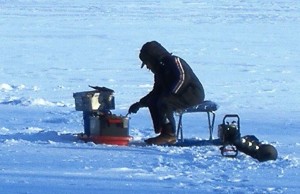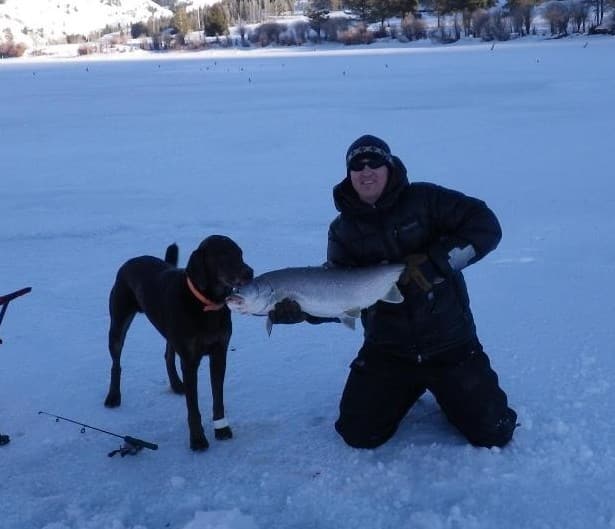This post was last updated on December 3rd, 2022 at 07:42 pm

Whether you live in the Midwest or out in the Rocky mountain states catching lake trout through the ice can be an exciting way to burn off your cabin fever. One thing about lake trout is that they can grow to massive sizes! it’s not uncommon to catch lakers of 30 pounds or more. Great lakes anglers have a tremendous opportunity to catch fish, particularly on Lake Michigan and Superior, but Western reservoirs offer great fishing as well. Almost all dammed up rivers will offer chances to haul in trophy lake trout in the Western states. Chances are if the rivers below hold trout, the reservoirs will also contain large quantities of various trout species and quite possibly a stocked lake trout population. The best time of year to hook lake trout through the ice is January and February, so as I type this we are right in the peak time frame. Hopefully this post will get you motivated to go out and give it a try.
 Most likely you already know whether or not the frozen lake you want to fish contains lake trout, so we will get into the tactics it will take for you to pull of a successful ice fishing trip for lakers. If you aren’t aware of a great spot to hook lake trout near you, contact your local bait shop and they will be able to steer you in the right direction.
Most likely you already know whether or not the frozen lake you want to fish contains lake trout, so we will get into the tactics it will take for you to pull of a successful ice fishing trip for lakers. If you aren’t aware of a great spot to hook lake trout near you, contact your local bait shop and they will be able to steer you in the right direction.
Finding Lake Trout
Large lake trout are commonly found in lakes with very deep water, in fact a lot of big fish are caught in depths of up to 250 feet. You can catch fish in as little as 8′ as they cruise the shallows looking to ambush baitfish or small fish such as yellow perch or smelt. Since lakers are predators that like to ambush their prey, you will likely find them in close proximity to cover or some type of structure.

They are relatively lazy fish and are not likely to chase down prey, so your chances of hooking them out in the middle of nowhere are less likely. If you have a vexilar or similar type flasher, you will be at a great advantage while fishing for these trout through the ice. These tools will help you locate areas that currently have baitfish, and that is where you should concentrate your ice fishing efforts. The more food that is available for the lake trout, the more likely they will be in the area searching for a meal.
Lake trout can often be hard to find through the ice, so you should be ready to move frequently if you are not seeing any action. Most successful lake trout anglers will have a snowmobile or vehicle of some sort on the ice to be able to move around freely. If you are totally lost about where to find fish you can always nose around near other ice fisherman and pick their brains a little bit. Even if they are being secretive, you can usually tell if they have caught fish by looking for blood on the ice. Another sneaky tactic to find a great spot is to pay attention to how often a fisherman hits a certain spot. If they are fishing in the same hole 3 days in a row they are either catching a lot of fish, are really stubborn or they are simply sitting out their so they don’t have to spend time with their wife.
The Fishing Procedure
The standard practice for fishing for lakers involves dropping your bait all the way down to the bottom and reeling it up 8-14″, putting it right in the most probable area for it to end up in front of a fishes face. From this point you will want to jig your lure using 1-2 feet of arm movement to give it a little action. I personally will jig about every 5 seconds and often times between jigs I will give my rod a little shake to make the lure/bait pulsate and tease the fish into striking. Most often the fish will strike your lure as it descends back down toward the bottom. You will often feel a little tap as the strike occurs, but typically you won’t feel anything until you lift your rod again on your next jig. When you feel the weight of the fish as you lift, you will need to keep lifting (clear over your head) and give it a hefty hookset. Since these fish will likely be in very deep water, you should be sure you really pop them hard and often more than once. Due to the stretch of the line and the amount you will have out, it can be difficult to get the hook properly buried in the lake trout’s mouth. If you start to get any slack in the line many people will actually stand up or move away from the hole until the line has adequate tension.
Baits to Use
My personal favorite lures for lake trout through the ice are spoons tipped with the front half of a minnow. Simply break the minnow in half and hook it through the head on your hook. If you are using a tip-up you will want to use a living minnow to attract the fish, because you won’t be there to jig it. Common baits for lake trout include smelt, small perch (if legal in your area) large blue or emerald shiners or even golden shiners. Fish in particular areas tend to have a preference, so you might have to experiment a little. If you are fishing in a lake that is known for a large smelt or shiner population, then that is the bait you should choose. Ice fishing for lake trout is just like any other type of trout fishing, matching the hatch is a key to success.
Gear Needed For a Successful Trip
- 8-10 inch ice auger
or spud
- Ice spoon or scooper
- Rod and reel with 6-12 pound test line
- Bait (herring, smelt or shiners)
- Spoons or jigs
- Bucket to carry it all in
- Camera
- Warm clothing
Optional Gear
- Vexilar flasher
- Plenty of junk food
- Ice shelter
- Snowmobile or 4 wheeler
Image by Amy Mingo on Flickr. Used under creative commons license 2.0.


